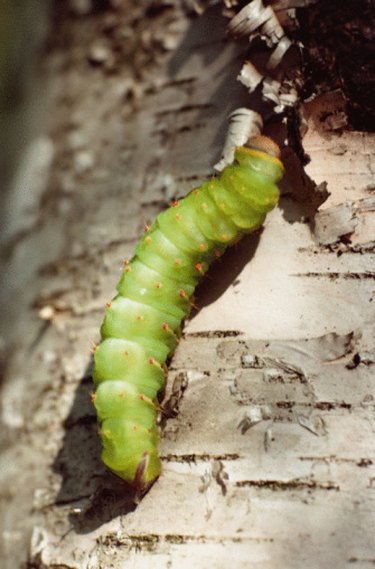
When you find a caterpillar in your front yard, imagine what kind of attractive butterfly or moth it will become, and what colors and designs the butterfly will have. Caterpillars are butterfly and moth larvae that mainly focus on eating and growing until they reach maturity. Caterpillars then hide under leaves or plant stems and spin silk around their bodies, creating pupae or chrysalises from which butterflies emerge. Knowing how to find a caterpillar in your front yard may help you decide to turn your front yard into a butterfly haven, or exterminate the caterpillars as pests.
Step 1
Examine the trees and plants in your front yard, paying attention to the leaves, including underneath the leaves. Look for damaged tree leaves, which indicate the presence of caterpillars feeding on leaves. You may see caterpillars openly eating the leaves, or hiding on branches and in tree cracks during the day.
Video of the Day
Step 2
Inspect the ground for crawling caterpillars, especially in flowers, ferns, under stones, in stacks of wood, logs or decomposing leaves.
Step 3
Look at the leaves of weeds in your front yard. For example, milkweed grows from 1 to 5 feet in height, has clusters of pink, orange or white flower,s and oozes a milk-like sap when you tear the stems, leaves and pods. Milkweed attracts monarch caterpillars, which have black and yellow stripes on white bodies, and turn into butterflies with black and bright-orange wings tipped by white dots.
Step 4
Locate caterpillars in your front yard at night by using a flashlight, since a large number of species prefer to feed at night.
Tip
Capture a caterpillar once you find one and raise it as a pet in an inexpensive, hard, clear plastic cup topped with netting secured with a rubber band. Feed the caterpillar the same food it was eating when you found it. Clean the cup whenever it gets dirty by removing the caterpillar, then using a solution of 90 percent water and 10 percent bleach to clean the container.
Handpick caterpillars from plants in your front yard if they are killing your plants. If you find numerous caterpillars on your plants, use natural Bacillus thuringiensis (Bt) insecticides, which stops caterpillars from feeding on the plants. Follow the instructions on the insecticide label.
Video of the Day